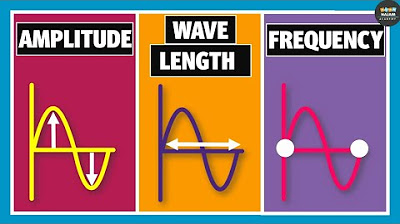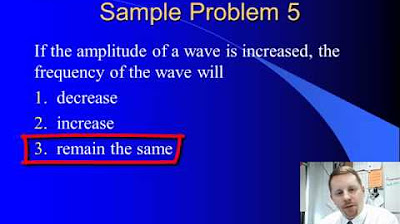Grade 10 Transverse waves Exam question Wavelength
TLDRThe video script is an educational guide on understanding wave properties, specifically focusing on determining the number of wavelengths between two points, calculating amplitude, and wavelength. It uses a practical example with a visual wave diagram to illustrate how to count wavelengths and identify points in phase. The amplitude is explained as the maximum disturbance from the equilibrium position, and a method for calculating wavelength is provided, emphasizing the importance of distinguishing between horizontal and vertical distances on a wave diagram.
Takeaways
- 📏 Determining the number of wavelengths involves identifying full complete waves between two points in phase.
- 🌟 To find a wavelength, connect two successive points in phase, which defines one complete wavelength.
- 📈 When counting wavelengths, start from a point just before a crest and move to the next point in phase.
- 🔍 To calculate the amplitude, measure the maximum vertical distance from the equilibrium position to the crest or trough.
- 🤔 The amplitude is not the distance from crest to trough, but rather half of that distance, representing the maximum disturbance.
- 📐 For determining the wavelength of a wave, the focus should be on the horizontal distance between successive points in phase, not the vertical distance.
- 👀 When given a distance (e.g., 5m), count the number of full and partial waves within that distance to find the wavelength.
- 🧩 To find the wavelength, divide the total distance by the number of full and partial waves counted between two points.
- 🌊 Understanding the concept of in phase and out of phase points is crucial for accurate wave analysis.
- 📚 Practice with past exam papers and related video content can enhance comprehension of wave properties.
- 🔗 For further study on waves, refer to the playlist provided in the description box for additional resources.
Q & A
What is the main topic of the video?
-The main topic of the video is to teach how to determine the number of wavelengths between different points, calculate amplitude, and determine the wavelength of a wave.
What is the significance of understanding wavelengths, amplitude, and points in phase?
-Understanding wavelengths, amplitude, and points in phase is crucial for studying and analyzing wave patterns, which is a fundamental concept in physics and helps in solving related problems in classwork or exams.
How is a wavelength defined in the context of the video?
-A wavelength is defined as the distance between two successive points in phase, which means the distance between two points that are in the same position in their cycle of the wave.
What is the method to calculate the number of wavelengths between two points A and F?
-To calculate the number of wavelengths between two points A and F, one must identify the points that are in phase and count the full waves between them. In the example given, there are two wavelengths between points A and F.
How can one determine the amplitude of a wave?
-The amplitude of a wave is determined by finding the maximum disturbance of a particle from its equilibrium position. It is calculated as the vertical distance from the equilibrium position to the crest or from the equilibrium position to the trough.
What is the amplitude in the example provided in the video?
-In the example provided, the amplitude is half of the 50 cm distance given, which is 25 cm, since amplitude is not measured from crest to trough but from the crest (or trough) to the equilibrium position.
How can the wavelength of a wave be determined if only the distance between two points A and H is given?
-To determine the wavelength when only the distance between two points A and H is given, one must first count the number of full waves and fractions of waves between A and H. Then, divide the given distance by the number of waves to find the wavelength.
What is the formula used to calculate the wavelength in the video?
-The formula used to calculate the wavelength in the video is: Wavelength = (Total Distance / Number of Waves). In the example, the wavelength is calculated as 5 m / 2.5 waves, which equals 2 m.
Why is it important to distinguish between horizontal and vertical distances when analyzing waves?
-It is important to distinguish between horizontal and vertical distances because the horizontal distance (wavelength) represents the distance between successive points in phase, while the vertical distance (amplitude) represents the maximum disturbance from the equilibrium position. These are separate measurements crucial for understanding wave properties.
How can one differentiate between full waves and fractions of waves?
-Full waves are complete cycles from one point in phase to the next, while fractions of waves represent parts of a cycle. For example, a half wave would be from the equilibrium position up to the crest or down to the trough, and a quarter wave would be one-fourth of a full cycle.
What is the purpose of the video link in the description box mentioned in the video?
-The video link in the description box is provided for additional learning resources. It leads to a playlist that covers more topics related to waves, which can help viewers gain a deeper understanding of the subject matter.
Outlines
🌟 Understanding Wavelengths and Wave Count
This paragraph introduces the concept of determining the number of wavelengths between two points, given in a problem. It explains the process of identifying full wavelengths by connecting two successive points in phase and counting the number of complete waves from one point to another. The speaker uses a practical example from a past exam paper to illustrate how to count wavelengths from point A to F, emphasizing the importance of recognizing points in phase and how to calculate the amplitude and wavelength of a wave.
📏 Calculating Amplitude and Fractional Wavelengths
The second paragraph delves into the calculation of amplitude, which is defined as the maximum disturbance of a particle from its equilibrium position. The speaker clarifies the difference between amplitude and wavelength, using a diagram to identify the vertical distance required for amplitude calculation. The paragraph also addresses the challenge of calculating the number of fractional wavelengths between points A and E, demonstrating how to count full waves and then break down the remaining distance into halves or quarters to arrive at an accurate count.
🧮 Determining Wavelength from Given Distance
This paragraph focuses on the method to determine the wavelength of a wave when given a certain distance between two points, A and H. The speaker explains the step-by-step process of first counting the number of waves between the two points and then dividing the given distance by the number of waves to find the wavelength. The explanation includes a clear demonstration of how to identify successive points in phase and how to handle non-integer numbers of wavelengths, ultimately leading to the calculation of a wavelength of 2 meters in the provided example.
Mindmap
Keywords
💡Wavelength
💡Amplitude
💡Equilibrium Position
💡Crest
💡Trough
💡Phase
💡Transverse Waves
💡Points in Phase
💡Wave Count
💡In Phase and Out of Phase
💡Practice and Study
Highlights
The video introduces a method for determining the number of wavelengths between two points.
Amplitude is calculated as the maximum disturbance of a particle from its equilibrium position.
Wavelength is defined as the distance between two successive points in phase.
The video uses a practical example from a past exam paper for better understanding.
A wave's amplitude is found by taking a vertical distance from the crest to the equilibrium position or from the trough to the equilibrium position.
To find the wavelength, one must count the number of waves between two points and divide the distance by that number.
The video emphasizes the importance of identifying points in phase when counting wavelengths.
For calculating the number of wavelengths between points A and F, two wavelengths are found.
When determining the number of wavelengths from A to E, the count results in a fraction of a wave, specifically 1.75 waves.
The video provides a clear explanation of how to differentiate between full waves and partial waves.
A detailed breakdown of how to visually identify and count the number of wavelengths in a wave is provided.
The video offers a method to calculate the wavelength by dividing the total distance by the number of waves.
The importance of understanding the difference between amplitude and wavelength is stressed in the video.
The video instructs on how to handle and calculate when the number of wavelengths is not a whole number.
A comprehensive guide on how to approach and solve problems related to transverse waves is presented.
The video encourages viewers to review additional resources for a deeper understanding of wave-related concepts.
Transcripts
Browse More Related Video

Calculating amplitude, frequency,wavelength and period of a wave

Wavelength, Frequency, Time Period and Amplitude | Physics

Exam Transverse Waves Grade 10

AP Physics Workbook 10.A Properties of a Wave

High School Physics - The Wave Equation

Label & Draw Transersve Waves: Amplitude, Frequency, Wavelength, Crest, and Trough
5.0 / 5 (0 votes)
Thanks for rating: